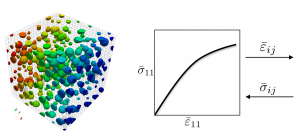Prof. Ahmad R. Najafi had a presentation at the 13TH WORLD CONGRESS ON COMPUTATIONAL MECHANICS (WCCM2019) and 2nd Pan American Congress on Computational Mechanics on Thursday, July 26, 2018.
Title:
Design of Nonlinear Materials Using a Multi-scale NURBS-based Shape Optimization Scheme
Authors:
Ahmad Najafi *, Masoud Safdari, Daniel Tortorelli, Philippe Geubelle
Abstract:
Due to recent advances in manufacturing techniques over the past decades, the tailoring of materials with specific macroscopic properties has been the focus of active research in mechanical engineering and materials science over the past decade. The key challenge in this line of work is how to optimize the material microstructure at the mesoscale to achieve a desired macroscopic constitutive response. In this work, we present a method to design the structure of particulate composites at the mesoscale using a shape optimization scheme to minimize or maximize a nonlinear objective function at the macroscale while satisfying a set of constraints (associated, for example, with the volume fraction of inclusions or with the manufacturing technique). Three key elements of the presented technique are i) multiscale nonlinear modeling, ii) sensitivity analysis, and iii) optimization. The multiscale modeling is based on a nonlinear finite element scheme, which combines a classical homogenization scheme with a NURBS-based Interface-enriched Generalized Finite Element Method (NIGFEM) used for accurate and efficient capturing of the displacement field in a heterogeneous material with a finite element discretization that does not conform to the material interfaces. Damage evolution is captured using a three-parameter isotropic damage model, which is applicable to a wide range of failure responses. To perform sensitivity analysis, we formulate a NIGFEM-based analytic nonlinear sensitivity scheme, which is simplified by the fact that only the enrichment control points on material interfaces move, appear or disappear during the shape optimization process. The selected scheme avoids the technical difficulties encountered in the finite difference schemes when the boundary intersects an element very close to a node in a non-conforming mesh. In these situations, the boundary may move to another element during the design perturbation step, resulting in changes of the mesh topology, making the differentiation of the stiffness matrix and load vector problematic. The last part is a gradient-based shape optimization scheme that relies on the stationary nature of the non-conforming meshes used to discretize the periodic unit cell, thereby avoiding mesh distortion issues that plague conventional finite-element-based shape optimization studies. In the current approach, the finite element approximation space used in the NIGFEM is augmented with NURBS to allow for the accurate capture of the weak discontinuity present along complex, curvilinear material interfaces. To demonstrate the performance of the method, we present a set of microstructural shape optimization problems with applications in the linear and nonlinear design of heterogeneous particulate composites.
He was also a Co-author for a keynote presented in Mini-symposium on “Computational Materials Design: Emerging Multiscale, Optimization and Reconstruction Techniques” at the WCCM2018.
Title:
Authors:
Philippe Geubelle *, Marcus Tan, Stephen Pety, Ahmad Najafi, Scott White
Abstract:
Inspired from many living organisms, microvascular composites form a new class of fiber-reinforced polymeric matrix composites that contain a circulatory system made of an embedded network of microchannels. Based on the choice of the fluid circulating in the microvascular network, a wide range of multi-functionalities are being considered for these materials, including autonomic healing of internal damage, switching embedded antennas, and active cooling for high temperature applications. A recent development in the manufacturing of this class of composites, based on specially treated sacrificial fibers that are woven in the original fabric, undergo the composite cure cycle before undergoing a vaporization process, has led to the creation of microvascular networks that are integrated directly into the composite microstructure. This technology is being considered for a variety of active cooling applications, including skin materials for hypersonic aircrafts, actively cooling of car batteries and radiative cooling of nanosatellites. This new manufacturing process provides a lot of flexibility in the configuration of the embedded network. To assist with the material design process, a novel numerical tool based on an interface-based generalized finite element method (IGFEM) has been developed to model accurately and efficiently the impact of the coolant flowing through the microchannels on the thermal field in the composite. A gradient-based shape optimization scheme is then used together with the IGFEM solver to optimize the configuration of the embedded microchannel network based on a variety of objective functions and constraints. A key advantage of the IGFEM/gradient-based optimization scheme resides in the stationary nature of the non-conforming finite element mesh, which allows for the capture of evolving network shapes without facing the mesh distortion issues associated with classical FE-based shape optimization methods. Various 2D and 3D configurations of the microchannels are investigated and compared, based on their thermal and flow efficiency and on their impact on the structural integrity of the composite. We also optimize the microchannel network for redundancy. The predicted thermal impact of the optimized microvascular networks is compared with experimental observations obtained using infrared measurements. Tan, M. H. Y., Najafi, A. R., Pety, S. J., White, S. R., and Geubelle, P. H. (2016) “Gradient-based design of actively-cooled microvascular composite panels.” International Journal of Heat and Mass Transfer, 103, 594-606. Tan, M., and Geubelle, P. H. (2017) “3D dimensionally reduced modeling and gradient-based optimization of microchannel cooling networks.” Computational Methods in Applied Mechanics and Engineering, 323, 230–249.

